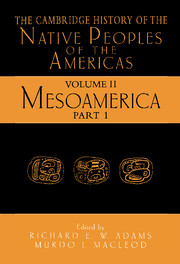Book contents
- Frontmatter
- Contents
- List of Illustrations
- Part I
- 1 Introduction to a Survey of the Native Prehistoric Cultures of Mesoamerica
- 2 The Paleoindian and Archaic Cultures of Mesoamerica
- 3 The Preclassic Societies of the Central Highlands of Mesoamerica
- 4 The Precolumbian Cultures of the Gulf Coast
- 5 The Maya Lowlands: Pioneer Farmers to Merchant Princes
- 6 The Central Mexican Highlands from the Rise of Teotihuacan to the Decline of Tula
- 7 Western and Northwestern Mexico
- 8 Cultural Evolution in Oaxaca: The Origins of the Zapotec and Mixtec Civilizations
- 9 The Southeast Frontiers of Mesoamerica
- 10 The Maya Highlands and the Adjacent Pacific Coast
- 11 The Aztecs and Their Contemporaries: The Central and Eastern Mexican Highlands
- Index
11 - The Aztecs and Their Contemporaries: The Central and Eastern Mexican Highlands
Published online by Cambridge University Press: 28 March 2008
- Frontmatter
- Contents
- List of Illustrations
- Part I
- 1 Introduction to a Survey of the Native Prehistoric Cultures of Mesoamerica
- 2 The Paleoindian and Archaic Cultures of Mesoamerica
- 3 The Preclassic Societies of the Central Highlands of Mesoamerica
- 4 The Precolumbian Cultures of the Gulf Coast
- 5 The Maya Lowlands: Pioneer Farmers to Merchant Princes
- 6 The Central Mexican Highlands from the Rise of Teotihuacan to the Decline of Tula
- 7 Western and Northwestern Mexico
- 8 Cultural Evolution in Oaxaca: The Origins of the Zapotec and Mixtec Civilizations
- 9 The Southeast Frontiers of Mesoamerica
- 10 The Maya Highlands and the Adjacent Pacific Coast
- 11 The Aztecs and Their Contemporaries: The Central and Eastern Mexican Highlands
- Index
Summary
BACKGROUND
In Central Mexico (Map II.I) the period between the fall of Tula (C. A.D. 1150) and the conquest of Tenochtitlan by the Spaniards (A.D. 1521) is one of complex, dynamic, and rapid cultural evolution. All cultures in the area were at a state level of development; each represented a regional variant of a civilization with many shared common features (cf. Renfrew 1975:17, 1986:2). The major defining characteristics of the period include the breakup of the Tula macroregional state system that had incorporated and controlled much of Central Mexico, and the devolution of theToltec political and economic structure into small and separate city-state units (see Map 11.3). This devolution was followed by the emergence of the third and final prehistoric macroregional state system, that of the Aztecs.
In many respects the events of the period mirror those of the Early Toltec or Epi-Teotihuacan period (A.D. 650/750–900/950). Characteristic of that time, following the end of Teotihuacan, the first macroregional state of Central Mexico, but before the rise of Tula, there were population movements and the establishment of small independent sociopolitical units (Diehl and Berlo 1989:3-4; Marcus 1989) (Map 11.2). The sociopolitical units formed in the epi-Teotihuacan period were probably structurally and functionally equivalent to the city-states encountered by the Spaniards in Central Mexico in A.D. 1519 (Bray 1972).
The epi-Teotihuacan period ended with the rise of Tula as the first new major post-Teotihuacan state system in Central Mexico. Tula picked up the mantle of Teotihuacan, integrated much of Central Mexico, and influenced distant areas of Mesoamerica such as Yucatan (Charlton 1973a, 1975, 1978; Parsons, and Santley 1979:129the period between the fall of 49; Diehl 1981, 1983, 1993; Healan 1989a; Willey 1991; Marcus 19928:398the period between the fall of 99; Blanton et al. 1993:138the period between the fall of 42, 1996:10; Charlton and Nichols 1995).
I should note that according to Parsons, Brumfiel, and Hodge (1993, 1995, 1996), recent radiocarbon dates suggest the possibility of some contemporaneity between ceramic complexes treated here as sequential. The epi-Teotihuacán period-defining Coyotlatelco ceramic complex may have coexisted with the final Teotihuacán period-defining Coyotlatelco ceramic complex (A.D. 650–750) in the southeastern Basin of Mexico at least in part. They also suggest that some later contemporaneity existed between Coyotlatelco, Mazapan (Early Postclassic), and Aztec I/II (Early Aztec period) ceramics (1996:24). Given the truly provocative but still regionally restricted data available, I have not at this time revised the post-Teotihuacán culture sequence. In the future such changes may be warranted.
- Type
- Chapter
- Information
- The Cambridge History of the Native Peoples of the Americas , pp. 500 - 558Publisher: Cambridge University PressPrint publication year: 2000
- 1
- Cited by



